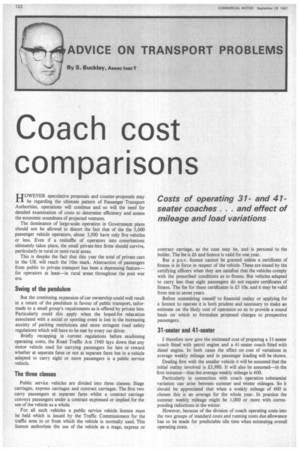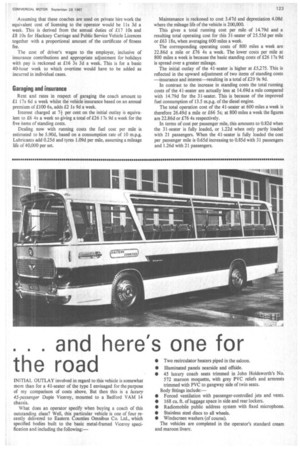Coach cost comparisons
Page 124

Page 125

If you've noticed an error in this article please click here to report it so we can fix it.
Costs of operating 31and 41seater coaches. . . and effect of mileage and load variations
HOWEVER speculative proposals and counter-proposals may be regarding the ultimate pattern of Passenger Transport Authorities, operations will continue and so will the need for detailed examination of costs to determine efficiency and assess the economic soundness of projected ventures.
The dominance of large-scale operation in Government plans should not be allowed to distort the fact that of the the 5,000 passenger vehicle operators, about 3,500 have only five vehicles or less. Even if a reshuffle of operators into conurbations ultimately takes place, the small private-hire firms should survive, particularly in rural or semi-rural areas.
This is despite the fact that this year the total of private cars in the UK will reach the 10m mark. Abstraction of passengers from public to private transport has been a depressing feature— for operators at least—in rural areas throughout the post war era.
Swing of the pendulum But the continuing expansion of car ownership could well result in a return of the pendulum in favour of public transport, tailormade to a small group's requirements as is offered by private hire. Particularly could this apply when the hoped-for relaxation associated with a social or sporting event is lost in the increasing anxiety of parking restrictions and more stringent road safety regulations which will have to be met by every car driver.
Briefly recapping in current regulations before exainining operating costs, the Road Traffic Act 1960 lays down that any motor vehicle used for carrying passengers for hire or reward whether at separate fares or not at separate fares but in a vehicle adapted to carry eight or more passengers is a public service vehicle.
The three classes Public service vehicles are divided into three classes: Stage carriages, express carriages and contract carriages. The first two carry passengers at separate fares whilst a contract carriage conveys passengers under a contract expressed or implied for the use of the vehicle as a whole.
For all such vehicles a public service vehicle licence must be held which is issued by the Traffic Commissioners for the traffic area in or from which the vehicle is normally used. This licence authorizes the use of the vehicle as a stage, express or contract carriage, as the case may be, and is personal to the holder. The fee is £6 and licence is valid for one year.
But a p.s.v. licence cannot be granted unless a certificate of fitness is in force in respect of the vehicle. These are issued by the certifying officers' when they are satisfied that the vehicles comply with the prescribed conditions as to fitness. But vehicles adapted to carry less than eight passengers do not require certificates of fitness. The fee for these certificates is £5 10s. and it may be valid from one to seven years.
Before committing oneself to financial outlay or applying for a licence to operate it is both prudent and necessary to make an estimate on the likely cost of operation so as to provide a sound basis on which to formulate proposed charges to prospective passengers.
31-seater and 41-seater I therefore now give the estimated cost of preparing a 31-seater coach fitted with petrol engine and a 41-seater coach fitted with diesel engine. In both cases the effect on cost of variations in average weekly mileage and in passenger loading will be shown.
Dealing first with the smaller vehicle it will be assumed that the initial outlay involved is £3,980. It will also be assumed—in the first instance—that the average weekly mileage is 600.
Particularly in connection with coach operation substantial variation can arise between summer and winter mileages. So it should be appreciated that when a weekly mileage of 600 is chosen this is an average for the whole year. In practice the summer weekly mileage might be 1,000 or more with corresponding reductions in the winter.
However, because of the division of coach operating costs into the two groups of standard costs and running costs due allowance has to be made for predictable idle time when estimating overall operating costs. Assuming that these coaches are used on private hire work the equivalent cost of licensing to the operator would be 1 Is 3d a week. This is derived from the annual duties of £17 1 Os and lOs for Hackney Carriage and Public Service Vehicle Licences together with a proportional amount of the certificate of fitness fee.
The cost of driver's wages to the employer, inclusive of insurance contributions and appropriate adjustment for holidays with pay is reckoned at £16 3s 3d a week. This is for a basic 40-hour week to which overtime would have to be added as incurred in individual cases.
Garaging and insurance
Rent and rates in respect of garaging the coach amount to £1 17s 6d a week whilst the vehicle insurance based on an annual premium of £100 6s, adds £2 is 9d a week.
Interest charged at 7+ per cent on the initial outlay is equivalent to £6 4s a week so giving a total of £26 17s 9d a week for the five items of standing costs.
Dealing now with running costs the fuel cost per mile is estimated to be 5.90d, based on a consumption rate of 10 m.p.g. Lubricants add 0.25d and tyres I.09d per mile, assuming a mileage life of 40,000 per set.
Maintenance is reckoned to cost 3.47d and depreciation 4.08d where the mileage life of the vehicle is 200,000.
This gives a total running cost per mile of 14.79d and a resulting total operating cost for this 31-seater of 25.55d per mile or £63 18s, when averaging 600 miles a week.
The corresponding operating costs of 800 miles a week are 22.86d a mile or £76 4s a week. The lower costs per mile at 800 miles a week is because the basic standing costs of £26 17s 9d is spread over a greater mileage.
The initial outlay of the 41-seater is higher at £5,275. This is reflected in the upward adjustment of two items of standing costs —insurance and interest—resulting in a total of £29 9s 9d.
In contrast to the increase in standing costs the total running costs of the 41-seater are actually less at 14.69d a mile compared with 14.79d for the 31-seater. This is because of the improved fuel consumption of 13.5 m.p.g. of the diesel engine.
The total operation cost of the 41-seater at 600 miles a week is therefore 26.49d a mile or £66 55; at 800 miles a week the figures are 22.86d or £76 4s respectively.
In terms of cost per passenger mile, this amounts to 0.82d when the 31-seater is fully loaded, or 1.22d when only partly loaded with 21 passengers. When the 41-seater is fully loaded the cost per passenger mile is 0.65d increasing to 0.85d with 31 passengers and 1.26d with 21 passengers.




































































































































































